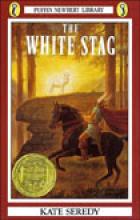Literature Early Middle Ages
The White Stag
Subject(s):
Setting:
Grade / Age level:
Review:
The White Stag by Kate Seredy is the telling of the legend of the migration of the Huns and Magyars out of Asia to the great Hungarian plains. It begins with Nimrod, an ancient leader of a wandering people who are always moving west, seeking a land that had been promised to them by their gods. At a moment of despair, his people sick and starving, Nimrod receives a message from his god, Hadur, which gives him hope and brings on his death. He is told that his two sons, Hunor and Magyar, will lead his people across the mountains and that another leader will rise up in their places when they are gone. Finally he is told that a great warrior leader, Attila the Scourge, will lead the people in the final phase of their migration.
The two sons do in fact lead the people west following a mysterious white stag which seems to be leading them along. They find a good land and stay there many years but it is not the land that was foretold. While in this land, Hunor and Magyar capture and marry fairy "moonmaidens." Hunor and his wife have a son named Bendeguz, The White Eagle. Among the people a slight rift appears and some become more attached to fierce Hunor and his son and others to the more gentle Magyar. The entire tribe moves on, however, and as they leave Asia and move into Europe, they become more fierce. The are in constant battle with the people of the lands they pass and end up a plundering, warring tribe. Finally they find a place to build a stronghold between the Volga and Don Rivers. Here Bendeguz marries a woman from the peoples they have conquered and Attila is born. The tribe then splits and Bendeguz, with Attila and his followers, move further west while Magyar and his followers stay. The Huns fight on and on with Attila as their leader and become the most feared people in the west. The story ends with the fulfillment of the prophecy, the finding of the promised land, and Attila leading a festival in thanksgiving to the great god Hadur.
This story could not be considered a history of the Huns, but might be read as a supplement to a study of the times. It is as the Greek myths are to the history of the Greeks and sheds light on the religion and traditions of the ancient Huns. It is poetically and lovingly written and full of beautiful illustrations. Since it is somewhat short in length, ( 95 pages of which 39 are full page illustrations), it can be read fairly quickly.
Recommended for grade 4+
The two sons do in fact lead the people west following a mysterious white stag which seems to be leading them along. They find a good land and stay there many years but it is not the land that was foretold. While in this land, Hunor and Magyar capture and marry fairy "moonmaidens." Hunor and his wife have a son named Bendeguz, The White Eagle. Among the people a slight rift appears and some become more attached to fierce Hunor and his son and others to the more gentle Magyar. The entire tribe moves on, however, and as they leave Asia and move into Europe, they become more fierce. The are in constant battle with the people of the lands they pass and end up a plundering, warring tribe. Finally they find a place to build a stronghold between the Volga and Don Rivers. Here Bendeguz marries a woman from the peoples they have conquered and Attila is born. The tribe then splits and Bendeguz, with Attila and his followers, move further west while Magyar and his followers stay. The Huns fight on and on with Attila as their leader and become the most feared people in the west. The story ends with the fulfillment of the prophecy, the finding of the promised land, and Attila leading a festival in thanksgiving to the great god Hadur.
This story could not be considered a history of the Huns, but might be read as a supplement to a study of the times. It is as the Greek myths are to the history of the Greeks and sheds light on the religion and traditions of the ancient Huns. It is poetically and lovingly written and full of beautiful illustrations. Since it is somewhat short in length, ( 95 pages of which 39 are full page illustrations), it can be read fairly quickly.
Recommended for grade 4+
Additional notes:
Newbery Medal Winner
Reviewed by:
First reviewed:
1998-99

